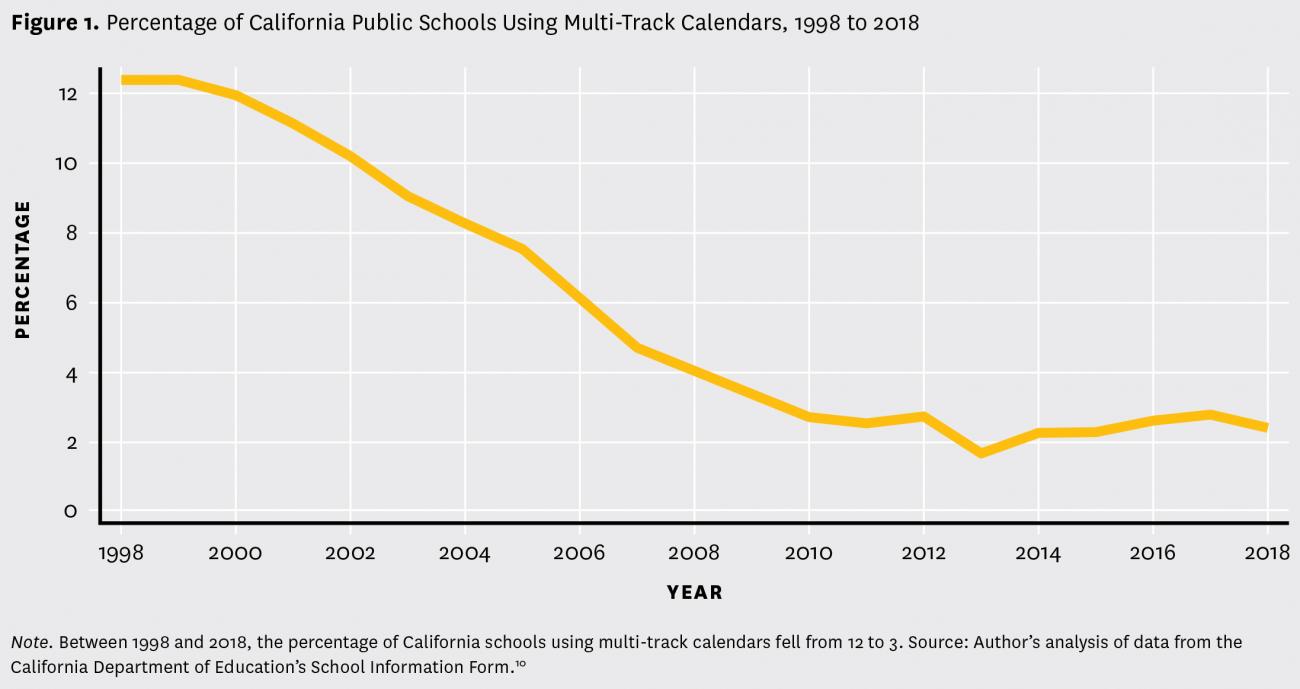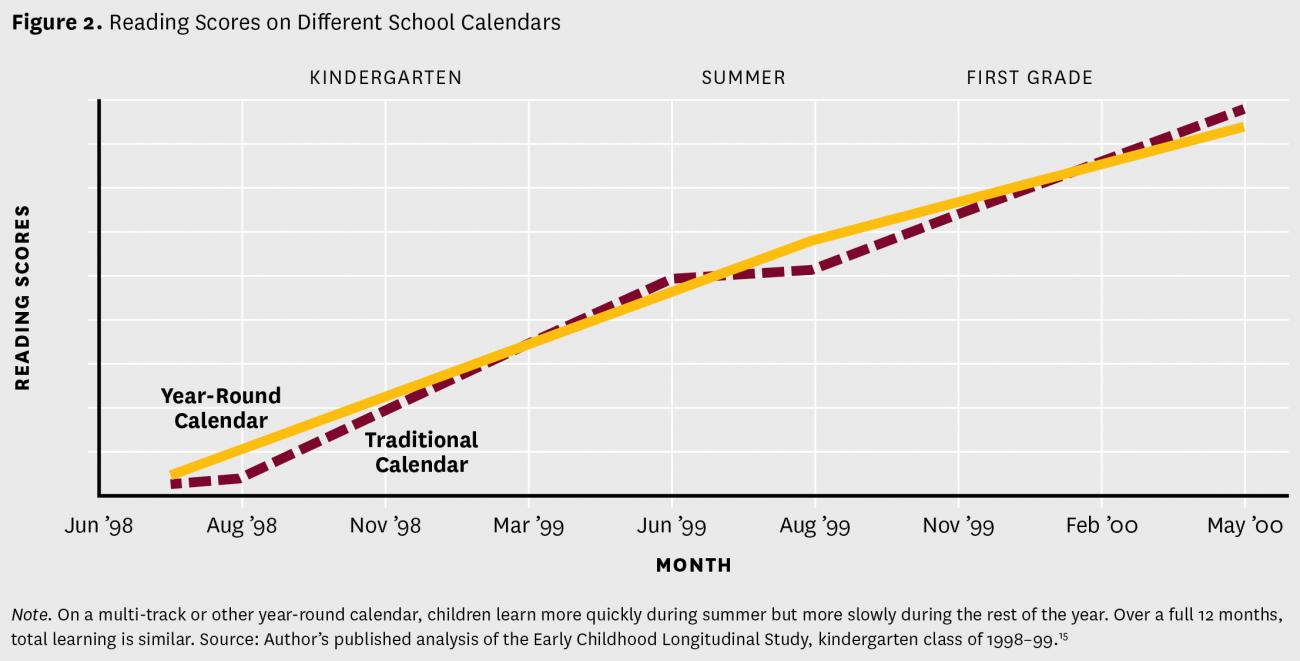What Does Research Say About Staggered School Calendars?
Summary
Governor Newsom has discussed staggered or multi-track calendars as an option for going back to school in fall 2020. A review of research on multi-track calendars shows that over time there are slight negative effects on learning, but this research was done during a period where the alternative was a traditional calendar. In the current situation, which would otherwise have students staying home entirely, a staggered calendar would have clear learning benefits and would help both parents and teachers get back to work. There is, however, no evidence that multi-track calendars reduce crowding enough to control COVID-19 transmission. Schools will need to look at evidence from other countries that are trying this approach and, if it is indeed implemented, would need to partner with local communities, counties, and the state to test aggressively for the virus.
Introduction
At a news conference on April 14, 2020, California Governor Gavin Newsom discussed ways students could avoid crowding and maintain social distance when schools reopen. One option was to use staggered school calendars so that not all students would be in the school building on the same day. Other states are considering staggered calendars for the same reason.
Although the idea sounds plausible, there is currently no evidence that staggered school calendars can reduce crowding enough to control infection rates. Even the broader question of how much school closures and openings affect the spread of COVID-19 is not yet settled.
Evidence may soon emerge from Hong Kong, Japan, Germany, Denmark, and Australia, which recently reopened some schools on a staggered schedule. But those countries combined staggered calendars with other policies. If infection rates rise or fall, it will be hard to know how much school calendars deserve the credit or blame.
There is research showing that staggered, or “multi-track,” school schedules can have small negative effects on student test scores and on parents’ and teachers’ ability to work. But those studies were all carried out at a time when the alternative was running schools on a traditional schedule. If the alternative is to keep children home, where they are now, any schedule that lets us open schools would have positive effects on children’s learning and on parents’ and teachers’ ability to work. But it is not clear whether any school schedule is safe until the incidence of COVID-19 has decreased and students can be regularly tested.
What is a “Multi-Track” Calendar?
On a “single-track” calendar, all students attend school at the same time—most commonly 9 months of school followed by 3 months of vacation. On a “multi-track” calendar, by contrast, different students are in school and on vacation at different times.
In California, multi-track calendars initially arose as a way to manage crowded schools. Crowding increased for two decades after the passage of Proposition 13 in 1978 made it hard for districts to fund school construction fast enough to keep up with population growth. In 1996, a class size reduction law further intensified crowding by requiring California elementary schools to hire 25,000 new K–3 teachers, increasing demand for classroom space. By 1998–99, 12 percent of California public schools, including 17 percent of elementary schools, were using multi-track calendars to handle overcrowding (see Figure 1).

Multi-track calendars divide students into three to five groups. Each group takes vacation at different times, so that one third to one fifth of students are on vacation at any time during the school year. In California, the most common multi- track calendar was a 60–20 calendar with three groups of students who alternated 12 weeks of school (60 days) with 4-week breaks (20 days), plus an extra 4-week vacation in summer. The next most common multi-track schedule was the Concept 6 calendar, which alternated 16 weeks of school with 8-week breaks, plus an extra 4-week vacation in summer.
Between 2000 and 2006, a series of reforms made it easier for districts to fund school construction and renovation, and by 2010–11, school buildings’ capacities had more or less caught up with population, eliminating the need for multi- track schedules. Today, less than 3 percent of California public schools use multi-track calendars, and the Concept 6 calendar has completely disappeared (see Figure 1). Since the Governor’s statement, though, multi-track calendars are back on the table as a way to reduce class sizes and, possibly, the risk of infection.
In this brief, I detail what we know from prior implementation about the impact of multi-track schedules on learning and on parents’ and teachers’ ability to work, and share recommendations for how this evidence can inform policy and practice in the current context.
Effects of Multi-Track Calendars on Learning from 1998 to 2010
Multi-track calendars are considered a form of “year-round” calendar, but the name “year-round” is somewhat misleading. Multi-track and most other year-round calendars do not increase the total time that students spend in school. Although they shorten summer break, multi-track calendars add or lengthen breaks in fall, winter, and spring. Overall, most multi-track calendars have 36 weeks of instruction (180 days), the same as traditional 9-month calendars; the Concept 6 multi- track calendar had only 32 weeks.
It was once hoped that multi-track and other year-round calendars could increase achievement. The hope was that, by shortening summer break, multi-track calendars would reduce the opportunity for summer learning loss, and that children would retain more across several short breaks than across one long one. Unfortunately, this turns out not to be true. The evidence on summer learning loss is less consistent than was once thought, and gains that children make when they are in school during summer are offset by slower learning due to breaks during fall, winter, and spring. Across all four seasons, teachers do no more teaching—and students do no more learning—on a multi-track calendar than on a traditional calendar (see Figure 2). From 1998 to 2011, California schools that switched calendars scored no higher—in fact they scored a percentile point lower—on multi-track calendars than on traditional calendars.

Effects of Multi-Track Schedules on Parents’ and Teachers’ Work
Multi-track calendars can be complicated for families to navigate. A family whose children are on different school calendars, or different calendar tracks, may find it hard to coordinate children’s school schedules with each other and with parents’ work schedules. Teachers with children can have scheduling problems when the schools they work at are on a different calendar, or a different calendar track, than the schools their children attend.
Probably for that reason, when a school uses a multi-track calendar, experienced teachers are more likely to leave and mothers are less likely to work outside the home. Nearby property values fall by 1.5 to 2 percent when a school adopts a year-round calendar, as most homeowners with children would rather live near a school that uses a traditional calendar.
Should Schools Implement Multi-Track Calendars this Fall?
Because multi-track schedules reduce crowding, they can look appealing if large classes and traditional calendars seem too risky for the spread of COVID-19. In the 1990s and 2000s, multi-track calendars successfully reduced the number of students in school at any one time without much impact on learning. The varied schedules made it hard for parents and teachers to work and manage childcare, but the tradeoffs seem different now than they were in the past. If the only alternative to multi-track calendars is keeping children home, then adopting multi-track calendars would substantially boost student learning and make it easier, not harder, for parents and teachers to do their jobs while still adhering to social distancing.
Multi-track calendars can seem like a way for schools to dip their toes in the water—a safe middle ground between fully reopening schools and keeping them closed. Yet the middle ground may be a mirage, since it is not yet clear how much multi-track calendars would actually reduce the transmission of COVID-19. The multi-track schedules used in the 1990s and 2000s only reduced the number of students in the building by one third to one fifth (e.g., from 25 to 20 or from 25 to 16). Would that be enough to noticeably reduce transmission? British teachers’ unions are now denouncing government plans to reopen schools with a maximum class size of 15, claiming that only a maximum of 10 to 12 would be safe. But it is not clear what any of these numbers are based on. Reducing California class sizes to 12 would require schedules more staggered than used previously—for example, a schedule with two groups of students attending school in alternate weeks. A schedule like that would require twice as many teachers, twice as many hours per teacher, or half as much instruction time per student.
Would any class size be safe? The risk of transmission depends not only on the number and proximity of students and teachers but also on how much time classes spend together, on classroom ventilation, and on what fraction of students and teachers are already infected before they come to school. If just one student were infected in a class that spent hours indoors with limited ventilation, it is not clear that even a class of 12 would be safe. On the other hand, if no one in a class were infected, there would be no chance of transmission even in a class of 30.
Since it is not clear what class size, if any, would keep children and teachers safe from infection, if California decides to reopen schools, on any schedule, it is vital to test students regularly and ensure that no one brings COVID-19 to school in the first place. Without regular and accurate testing, it has been argued, any plan to reopen schools is a gamble.
Endnotes and explanatory notes can be found in the full brief here.
This brief was produced in partnership with The Answer Lab at the USC Rossier School of Education.
von Hippel, P. T. (2020, May). What does research say about staggered school calendars? [Policy brief]. Policy Analysis for California Education. https://edpolicyinca.org/publications/what-does-research-say-about-staggered-school-calendars



